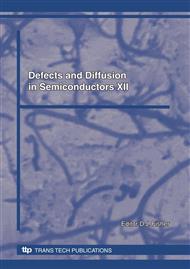[1]
J. O'M. Bockris and P. K. Subramanyan, A Thermodynamic Analysis of Hydrogen in Metals in the Presence of an Applied Stress Field, Acta Metallurgica, 19 (1971) 1205.
DOI: 10.1016/0001-6160(71)90053-8
Google Scholar
[2]
M.A. Guerrero a, C. Betegon, J. Belzunce, Fracture Analysis of a Pressure Vessel Made of High Strength Steel (HSS), Engineering Failure Analysis, article in press, (2007).
DOI: 10.1016/j.engfailanal.2007.06.006
Google Scholar
[3]
A. T. Yokobori, JR, T. Nemoto, K. Satoh, and T. Yamada, Numerical Analysis of Hydrogen Diffusion and Concentration in Solid with Emission around the Crack Tip, Engineering Fracture Mechanics, 55.
DOI: 10.1016/0013-7944(96)00002-1
Google Scholar
[1]
(1996) 47-60, G. Muller, M. Uhlemann, A. Ulbricht, J. Bohmert, Influence of Hydrogen on Toughness of Irradiated Reactor Pressure Vessel Steels, Journal of Nuclear Materials, 359 (2006) 114-121.
DOI: 10.1016/j.jnucmat.2006.08.004
Google Scholar
[4]
J Ulrich Krupp, Fatigue Crack Propagation in Metals and Alloys: Microstructure Aspects and Modeling Concepts, WILEY-VCH Verlag GmbH & Co. KGaA, Germany, (2007).
Google Scholar
[5]
Douglas M. Symons, A Comparison of Internal Hydrogen Embrittlement and Hydrogen Environment Embrittlement of X-750, Eng. Fracture Mech. 68 (2001) 751-771.
DOI: 10.1016/s0013-7944(00)00123-5
Google Scholar
[6]
C. J. McMahon Jr., Hydrogen-Induced Intergranular Fracture of Steels, Eng. Fracture, Mech., 68 (2001) 773-788.
DOI: 10.1016/s0013-7944(00)00124-7
Google Scholar
[7]
J. M. Smith and H. C. Van Ness, Introduction to Chemical Engineering Thermodynamics, McGraw-Hill, International edition, fourth edition, New York (1916).
Google Scholar
[8]
J. M. Prausnitz, R. N. Lichtenthaler, E. G. de Azevedo, Molecular Thermodynamics of FluidPhase Equilibrium, 3rd Edition, Prentice Hall International Series in Physical and Chem. Eng. Sci., New York (1998).
Google Scholar
[9]
C. R. Aronachalam, Hydrogen Charging and Internal Hydrogen Effects on Interfacial and Fracture Properties of Metal Matrix Composites, submitted by Michigan University, James places, Department of Material Science and Mechanics (1994).
Google Scholar
[10]
M. R. Louthan, Jr., Hydrogen Embrittlement of Metals: a Primer for the Failure Analyst, Materials Science and Technology, J. of Failure Analysis and Prevention, 8 (2008) 289-307.
DOI: 10.1007/s11668-008-9133-x
Google Scholar
[11]
H. P. Van Leeuwen, The Kinetics of Hydrogen Embrittlement: a Quantitative Diffusion Model, Eng. Fracture Mech., 6 (1974) 141-161.
DOI: 10.1016/0013-7944(74)90053-8
Google Scholar
[12]
J. Toribio, The Role of Crack Tip Strain Rate in Hydrogen Assisted Cracking, Corr. Sci., 39 (1997) 1687-1697.
DOI: 10.1016/s0010-938x(97)00075-9
Google Scholar
[13]
Y. Kim, Y. J. Chao, Marty J. Pechersky and Michael J. Morgan, On the Effect of Hydrogen on Fracture Toughness of Steel, Int. J. of Fracture, 134 (2005) 339-347.
DOI: 10.1007/s10704-005-1974-7
Google Scholar
[14]
J. O'M. Bockris and P. K. Subramanyan, A Thermodynamic Analysis of Hydrogen in Metals in the Presence of an Applied Stress Field, Acta Metall., 19 (1971) 1205.
DOI: 10.1016/0001-6160(71)90053-8
Google Scholar
[15]
H. P. Van Leeuwen, A Failure Criterion for Internal Hydrogen Embrittlement, Fracture Mech., 9 (1997) 291-296.
Google Scholar
[16]
Bong-Sang Lee, Min-Chul Kim, Maan-Won Kim, Ji-Hyun Yoon, Jun-Hwa Hong, Master Curve Techniques to Evaluate Irradiation Embrittlement of Nuclear Reactor Pressure Vessels for Long-Term Operation, Int. J. of Pressure Vessel and Piping, 85 (2008).
DOI: 10.1016/j.ijpvp.2007.08.005
Google Scholar
[17]
George Karzov, Boris Margolin, Eugene Rivkin, Analysis of Structure Integrity of RPV on the Basis of Brittle Criterion: New Approaches, Int. J. of Pressure Vessel and Piping, 81 (2004) 651-656.
DOI: 10.1016/j.ijpvp.2004.03.001
Google Scholar
[18]
A. Toshimitsu Yokobori Jr., Yasrou Chida, Takenao Nemoto, Kogi Satoh, Tetsuya Yamada, The Characteristics of Hydrogen Diffusion and Concentration around a Crack Tip Concerned with Hydrogen Embrittlement, Corr. Sci., 44 (2001) 407-424.
DOI: 10.1016/s0010-938x(01)00095-6
Google Scholar
[19]
A. T. Yokobori, JR, T. Nemoto, K. Satoh, and T. Yamada, Numerical Analysis of Hydrogen Diffusion and Concentration in Solid with Emission around the Crack Tip, Eng. Fracture Mech., 55 (1996) 47-60.
DOI: 10.1016/0013-7944(96)00002-1
Google Scholar
[20]
J. O'M. Bockris and P. K. Subramanyan, A Thermodynamic Analysis of Hydrogen in Metals in the Presence of an Applied Stress Field, Acta Metal., 19 (1971) 1205.
DOI: 10.1016/0001-6160(71)90053-8
Google Scholar
[21]
Hirokazu Kotake, Royosuke Matsumoto, Shinya Taketomi, Noriyuke Miyazaki, Transient Hydrogen Diffusion Analyses Coupled with Crack-Tip Plasticity under Cyclic Loading, Int. J. of Pressure Vessel and Piping, 85 (2008) 540-549.
DOI: 10.1016/j.ijpvp.2008.02.002
Google Scholar
[22]
Murakami, Y., The Handbook of Stress Intensity Factors, Pergamon (Oxford, New York), (1987).
Google Scholar


